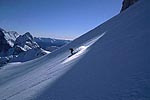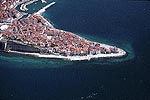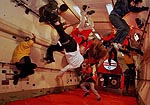On 25 May 2001, 3000 high school graduates danced the quadrille through the streets of Ljubljana, and as well as enrolling at university, were incidentally entered in the Guinness Book of Records. At the start of the 3rd millennium, several thousand experts in the technical, managerial and economic fields completed tertiary education in Slovenia. Their knowledge finally dispels the traditional notion of small countries and marks this time of accession to the European Union with new ambitions. A period of the free flow of ideas, goods and human resources brings to an end prejudices and increases opportunities. The popular national soccer team slogan "Slovenia goes on!" was one of the exuberant calls to those matriculating in 2001. Their energy promises a flourishing of imagination, determination, brightness, and a clearly outlined path. A sense of individualism and of challenging oneself, bred over the centuries, represents a good downpayment with which to set off on this path. Pannonia, the Alps, the Mediterranean: all three meet in a land smaller than the largest Mediterranean island. Geographies, cultures and climates fuse and lend character to this land covering 20,273 square kilometres. A total population of some two million people live in the few large centres - the capital Ljubljana, Maribor, Celje, Kranj, Novo mesto - and in the countryside. The relatively short sea coast and coastal belt rise sharply into the Karst region, which also gave this kind of limestone landscape its international name. Northwest of the central Ljubljana basin, the extreme tip of an Alpine range extends into Slovenia, along with Triglav, the country's highest mountain (2864 metres). Slightly further north, the Karavanke range marks the border with Austria, while the border with Hungary runs across the Pannonian plain, then marks the border with Croatia in a south-easterly arc to the River Kolpa. There are barely 200 kilometres as the crow flies separating the country's most distant points in the coastal region and along the Pannonian border. The skies were fairly clear on the day the state of Slovenia was born, the average temperature was 24 degrees centigrade, the calendar said 25 June 1991. On the basis of an 88.2 percent plebiscite vote, the Slovene parliament ceremonially adopted the Basic Constitutional Charter proclaiming Slovenia an independent state. Since the principality of Carantania in the 7th century, and its brief revival between 874 and 889, this was the first independent statehood for the land between the Alps and the sea which had accepted Christianity and the suzerainty of the Frankish Empire in the 8th century. It became part of the Habsburg dominions, or the Austro-Hungarian Empire, between the 13th and 16th centuries, and after the First World War joined other south Slav lands in the Kingdom of Yugoslavia. A session of the anti-fascist AVNOJ organisation in Jajce in 1943 included it as an independent republic in a new Yugoslav federation. In 1990, the Slovenes chose independence in a legitimately held plebiscite. Slovenia became a member of the UN on 22 May 1992, and that day marked an end to the isolation into which it had been thrust by the disintegration of Yugoslavia. The world's distrust continued anyway, but the new country, as an authority on the region, and having its most developed democracy, tenaciously sought and offered the possibility of dialogue to both sides throughout. This gradually strengthened its credibility, and today it is a politically recognised partner and adviser on the fringes of the turbulent Balkans. The path has led from acceptance into the United Nations to membership of the Security Council, the Council of Europe, the Organisation of Security and Cooperation in Europe (OSCE), the World Trade Organisation (WTO), International Monetary Fund (IMF) and other international organisations, and also to being the most serious candidate for Nato and European Union membership, throughout respecting the values held by countries of the modern world. It is a modern, progressive democracy, while retaining the unique aspects of a small nation that has not just survived a thousand years of foreign influence and rule but has started its new life a winner. The views that Slovenia expressed at the end of the eighties first raised it from anonymity. A voice of reason was heard from an insignificant Yugoslav republic, not concerned with nationalism but clearly directed at human rights and demanding clarity in the then economic circumstances. Slovenia's pragmatism has been vindicated by being far the most highly developed of the former Eastern Bloc states. Its trade for the most part with the economically advanced countries of Western Europe and strategic measures protected the country from economic collapse after the disintegration of Yugoslavia. Even before the Federal Army tried to prevent independence with an advance on the border on 27 June 1991, Slovenia had made new, perhaps sometimes not the most favourable but nonetheless crucial links with other economies, mainly in Europe. Slowly, seriously and consistently, it strengthened its reputation as a small but reliable partner, with a rational approach and an educated labour force. Today, in terms of per capita income, Slovenia leads the former Eastern Bloc countries. Its economy is stable, with good prospects, and suitable for cooperation with even the smallest partners from other countries. Over the course of these ten years, it has dismantled the old economy and rebuilt a new one. It has introduced its own currency - the Slovene tolar - has solid foreign exchange reserves, and a tax system increasingly aligned with that of Europe. Former socially owned enterprises have been fully privatised. It has a national shipping company and an airline, a stock exchange, a World Trade Center and other institutions. In 2000 it attained a GDP of US$ 9,105 per capita and inflation of 8.9 percent. Business risk assessments have for some years made it the lowest risk country of the Central and Eastern European transition countries. Unemployment has fallen in recent years. Business activities are increasingly liberalised, the currency exchange rate is encouraging, real interest rates are high, fiscal policy is cautious and it has a minimal budget deficit. The fickleness of history, living among larger neighbours, changing rules - this is the evolution of the Slovenes, what has made them adaptable to currents of thought, nurtured in them the importance of openness and demanded of them a good ear for languages. The nineteenth century was marked by the proximity of Vienna and its advance to the south. At the beginning of the twentieth century, Slovene culture breathed fresh air from Trieste. In the second half, the coexistence of nations and religions in the Yugoslav federation set out the overture for entry into a multicultural society of the 21st century. And Venice was always close, just a skip from the Slovene-Italian border. It's no wonder the Iron Curtain ceased to be an obstacle here, long before the great upheavals in Europe. Slovenia has always been at the crossroads: through Emona (Ljubljana), the Roman Empire linked Aquileia and Celje with distant Belgrade, and Trieste with the Croatian town of Sisak. The war expeditions of the Turks also advanced through the territory of Slovenia. Napoleon's conquests traversed Slovenia, and on its territory the French general established the Illyrian Provinces. The Austro-Hungarian Empire had its exit to the Mediterranean through Slovenia, and therefore in the 19th century built the railway line Vienna-Trieste. To the Slovenes, the upper North-Adriatic ports have since ancient times provided an access to the Mediterranean. One of the most ambitious joint projects between Slovenia and the European Union is the crossing of two major European transport routes in the Slovene capital. The shortest link between Southwest Europe and the Pannonian Plain (Barcelona-Milan-Ljubljana-Budapest- Kiev) and between the Balkans and Central Europe (Thessalonika-Belgrade-Zagreb- Ljubljana-Salzburg-Munich) will be a reality through Ljubljana in a few years. A number of European countries are involved in this important project. The cooperation of Slovene experts, builders and contractors contributes the experience of well organised and traditionally well qualified professionals that have built roads in Russia, the Middle East and elsewhere in the world. Priority national projects are preparing dedicated services for a future that will ensure the smooth flow of international traffic and will incorporate the new Slovene reality into this flow. The present human rights ombudsman in Slovenia was an avant-garde poet in the seventies. Today, he is author of a report on human development, and guardian of a heritage which must remain vital: a high level of respect for human and civil rights in Slovenia, as international reports put it. Experience from the past, a democratic culture and a legal order, these are especially sensitive areas in terms of rights of the individual, regardless of nationality, religious affiliation or world view. State and non-governmental institutions aimed at protecting them enjoy particular attention and support in their work. The legal protection of minorities is often cited as exemplary, and a basis for resolving problems in multicultural Europe. Slovenia is the only European country in which the national minorities - Italian and Hungarian - have their own representatives in parliament. The first printed book in the Slovene language came home in - barrels. It sounds like a tall story, but it's true. The author of this undertaking, canon, preacher, and not least priest, Primoz Trubar, was a Protestant and had to transport his translation of the Catechism secretly from the printing house in Tübingen or it would have been seized. A Slovene translation of the Bible followed not long after, in 1584, and was among the first dozen editions of the Bible in a national language in the world. In this culture, subversion is mixed with unbelievable adroitness into the national mission, and gave birth to such peaks as Zdravljica ("A Toast") by the poet of the Romantic, France Preseren, who proclaimed in the first half of the 19th century "that all men free no more shall foes but neighbours be". It's no wonder that it became the national anthem of the new country on independence, on the threshold of a Europe without borders. The avant-garde of the 20th century, relaxed artistic and cultural life during the resistance movement, long the only eastern opening to contemporary phenomena of Western art after the Second World War, and of course the cultural revolt at the end of the eighties - all this is a heritage that the Slovene cultural memory retains just as well as it renovates the cultural monuments neglected in recent decades. The first gravity-free theatre performance was on 17 August 1999, in an aircraft over Moscow, organised and staged by Slovene director and performer Dragan Zivadinov and his group. Artistic production in Slovenia is as lively as ever. The network of cultural foundations is still solid and effective. Slovenia has 9 professional theatres, 2 opera houses, 2 opera and 2 symphonic orchestras, a philharmonic orchestra, 60 libraries, and its own film and television production companies. The unimaginable mass of small groups, societies, creators and cultural managers complement them with fringe and alternative productions. If open-air concerts and theatres typify the summer months, autumn and winter are the time of gallery harvests and laden shelves in libraries and bookshops: eighteen books per 10,000 inhabitants are published annually in Slovenia. Elite events such as the European Month of Culture in 1997 or Manifesta 2000 attract an art audience to the Slovene capital from all over the world. The international theatre festivals, Mladi levi and Exodus, the Obalne galerije in Piran, and alternative societies, all transfuse new ideas and fresh aesthetics across Slovenia. Lipizzaner is a word with a Slovene pedigree. The white horses are named after Lipica, the stud farm in the Karst where the Vienna court bred its mounts. This is basic ecology; created long before it became a science - its importance bound to survival, and knowledge of it to experience. Breeding bees, for instance: it was an important supplementary activity in the past. The beekeeper, Anton Jansa, established a Slovene trademark in this in the 19th century, when he bred a specially robust and productive bee, known throughout the Austrian Empire and beyond as the Carniolian bee. Holiday makers discovered Slovene natural spas at that time - mountain, thermal and coastal. In the midst of unspoilt nature, beside springs and by baths and promenades, the forerunners of today's tourists enjoyed the hospitality of mountain guides and discovered the treasures of green Slovenia. National parks cover almost a third of the area of the country today, and the state has drawn their boundaries because it puts conservation of nature above everything else. Strict environmental protection regulations prevent uncontrolled encroachment that could destroy the ecologically extremely well maintained balance, which is particularly delicate in such a small space. If Slovenia can be a model to Europe in anything, it is nature conservation. Care for the forests. Preserving the cultural landscape. A ban on encroachments that could harm the ecosystem. Consistent protection of threatened animal and plant species. Bears have made a comeback here, and there's still a little virgin forest preserved near Kocevje. Fish stocks in the rivers testify to their cleanliness, and with the closing of old factories, it is not just obsolete production that is disappearing but a much greater evil - major polluters. Not that any of this restricts access to nature; access points are laid out everywhere, in harmony with the latest environmental wisdom and with those who want to enjoy it. Crossing the frontiers of the European Union simply with one's identity card, without a passport, already puts Slovenes in the position of full Europeans. There are daily signs that it is not long to full membership. Slovenia has already aligned a large part of its laws with the Community acquis. It adopted a change to the Constitution in May of this year allowing the sale of real estate to foreigners. Trade with European countries accounts for 66% of Slovene trade, and ever more Slovene companies are not just partners with European owners but are also themselves selecting the most advantageous business partners throughout Europe. With the introduction of European VAT and financial, pension and social reforms, it is adapting its systems for final accession to the Union. That will close a story begun in 1991, and open new challenges: how, together with other small nations of Europe, to retain its identity; not just to keep the main advantages of a philosophy born over centuries, but to give it effect within the logic of larger nations. |














